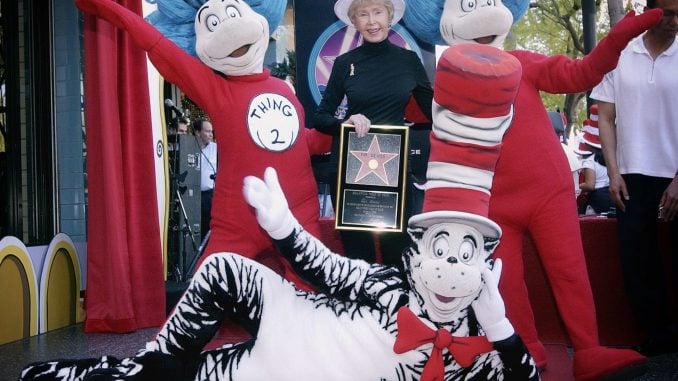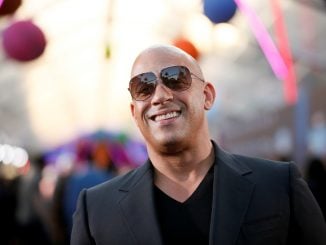
It was a mission Audrey Geisel embraced for more than a quarter-century. As overseer of Dr. Seuss’ prolific and lucrative literary estate, she carefully guarded the whimsical works of the writer and illustrator less known as Theodor Geisel and expanded the Seuss legacy. She promoted a highly profitable multimedia brand, from books and films to theme park rides and the Broadway show “Seussical.”
Audrey Geisel, 97, died Wednesday at her home in the La Jolla section of San Diego, Random House Children’s Books announced.
Geisel, who founded Dr. Seuss Enterprises, said she took to heart the responsibility her husband left her when he died in 1991.
“You keep a firm control as if they really were your children,” Geisel told The Associated Press in 1998. “I don’t want the Cat in a bad part of town, so to speak.”
But she went far beyond keeping a tight grip on the empire. She broadly expanded it beyond what her husband cared to do while creating his 47 children’s stories.

And, oh, the places she went with it.
More than 10 million Dr. Seuss books sell each year and new works are coming out, such as last spring’s “Dr. Seuss’s First 100 words,” according to Random House.
The 2000 live-action film version of “How the Grinch Stole Christmas,” starring Jim Carrey, was a box-office smash. But Audrey Geisel and critics despised the 2003 live-action adaptation of “The Cat in the Hat” that starred Mike Myers of “Austin Powers” fame.
“I never saw ‘Austin Powers,’ but I knew ‘Yeah, baby!’ and I didn’t want ‘Yeah, baby!’ at all,” she told the AP in 2004.
Geisel is credited as executive producer of the animated film “The Grinch,” which was released last month and tapped Benedict Cumberbatch to voice the title character.
A poll conducted by AP-NORC earlier this month put “The Grinch” just behind “It’s a Wonderful Life” of favorite holiday films or television. It didn’t specify if it was the Carrey version or the animated 1966 classic produced by Chuck Jones and narrated by Boris Karloff.
The movies have been lucrative with the recent “Grinch” production earning $245 million at the box office, according to Comscore. Animated film versions of “The Lorax” raked in $214 million and “Horton Hears a Who” made $154 million.
While Geisel has kept a tight rein on productions and merchandising, some of those efforts may have departed from Seuss’ spirit, said Philip Nel, an English professor at Kansas State University, who wrote “Dr. Seuss: American Icon.”
A group of books, for example, that use the Cat in the Hat as a conventional educator stray from the character’s rebellious roots, Nel said. Another book titled “Seuss-isms for Success” takes Seuss quotes out of context to apply to business situations.
“There’s been some pretty great stuff, too,” Nel said. “The animated Horton film was really thoughtfully done and understood the Seuss universe really well.”
Geisel was a Chicago native and former nursing student at Indiana University.
She and Theodor Geisel, who was 17 years older, were both married to other people when they began an affair in the 1960s. His first wife, Helen, killed herself.
Audrey Geisel sent the two daughters she had with her first husband to boarding school after the Geisels married in 1968. The couple had no children together — Seuss was not particularly fond of kids, she said.
“He was afraid of children to a degree,” Audrey Geisel told AP.
Geisel said she understood the gravity of what she was undertaking when her husband died, but said she was surprised how much work it was to oversee the business and philanthropy of the Dr. Seuss Foundation.
She tooled around tony La Jolla in a Cadillac with a license plate that read: GRINCH. And she showed up at events that celebrated her late husband.

In 2002, Geisel helped unveil bronze sculptures of Seuss and some of his most beloved characters at The Seuss Memorial in his hometown of Springfield, Massachusetts. The works were created by her daughter, Lark Grey Dimond-Cates.
When Audrey Geisel unveiled the sculpture of her late husband seated at his desk, her light blue eyes brimmed with tears as she bent down and kissed it.
Despite any anxiety her husband may have had around children, she wanted kids to crawl on the sturdy works.
“I’d like certain parts of it to get real shiny,” she said, “because they have been rubbed so many times by little grubby hands.”
In addition to being Seuss’ protector and promoter, she also influenced his work.
When Seuss was writing the book that became “The Lorax,” he got writer’s block and she suggested they take a trip to get unstuck, Nel said. They traveled to Kenya, where workers cutting down acacia trees sparked an idea.
“He thought, ‘They can’t cut down my Dr. Seuss trees’ — which he renamed truffula trees — and invented the Lorax to protect them,” Nel said.



